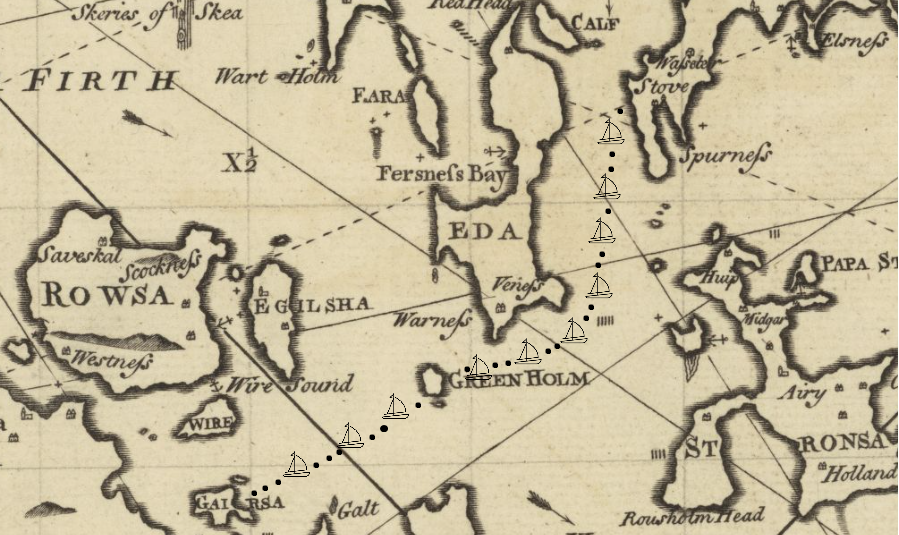
15/02/2025, by aezcr
In the wake of Sveinn Ásleifarson: the lost place-names of Hellisey and Vǫlunes
In chapter 95 of the Saga of the Earls of Orkney we hear of one of the many scrapes of the ever-quarrelsome Sveinn Ásleifarson. On leaving Gairsay after a failed attempt to confront Earl Haraldr ( who was not there as he ‘had gone to a small island to hunt hares’), Sveinn ‘made for Hellisey; that is an island with sea-cliffs and a large cave in the mountain’ where ‘the sea washes past the entrance to the cave at high tide’. Sveinn, being pursued and realising the precariousness of his position, decided to row into the sea cave to hide and throw Haraldr off his scent:
‘Sveinn left his ship behind in the cave and they took an old cargo-ship in the island, which had belonged to monks, and made for Sanday. They went ashore there and pushed the cargo-ship off, and it was driven around the shores until it was wrecked. And Sveinn and his men went onto the island and came to the farmstead by the name of Vǫlunes; a man by the name of Bárðr, a relative of Sveinn’s, lived there’ (chapter 95).
The whole story is one of derring-do, but where does this action-packed adventure take place? The starting place, Gáreksey, is Gairsay, an easily identifiable island, but what about Hellisey and Vǫlunes? Neither place-name seems to be definitively assigned to identifiable places today.
Taylor was the first to discuss the potential whereabouts of Vǫlunes’ in Sanday (Taylor: 41–45), and Clouston suggested that the place may have been in or near the field now called Volyar near Stove (Sinclair and Clouston: 246). In fact it was Marwick, who else, that first suggested this proposing, not unreasonably, that the name may have been used for the whole peninsular that is now known as Hacks Ness. The field of Volyar is marked on the map below, and it is evident that it sits easily within the area of the large estate that came to be known as Stove. The field was also known as The Great Stead o Volyar, a name which suggests that there may have been a building of some significance here (Marwick, 1923: 24).
Another form of the name appears to be the Waldgarth found in the 1595 rental. For this name Taylor proposed three interpretations for the first element: ON vǫlr ‘a round stick or blunt edge’, ON vala ‘a knucklebone, perhaps a nickname’, and ON vǫlva ‘a witch’ or ‘fortune teller, sorceress, prophetess, seeress, wise woman’. While vala and vǫlva work grammatically, vǫlr does not and notably occurs only as a suffix in words with which it compounds (Cleasby and Vigfusson). Of the otions, Taylor prefers a vǫlva interpretation (Taylor: 44), although vala as a personal nickname or perhaps a knuckle-shaped topographical feature remains possible, if not more plausible. ONP also suggests ‘branch’ or ‘joint’ as a possible translation for vala which also works topographically for the shape of the ness (Judith Jesch, personal comment). An incomplete ONP entry for a place-name, Vǫlubú, is tantalising but no details of where this place is, for a topographical comparison, are given.
Whilst being the first to suggest a possible location for this place Marwick deemed the first element ‘obscure’. He did note form other documentary evidence, however, that Waldgarth was located in Voxetter, ON vág-setr ‘bay homestead’, a now lost tunship (Marwick, 1952: 17). This name is eminently suitable for the area around the field of Volyar and the wider area of Stove. Marwick goes on to discuss at length the instability of names in the wider Bay of Stove area, and how a large area ‘that stretched in continuity for about two miles… once formed one large estate’ (Marwick, 1952: 14–16). Stove from ON stofa ‘a room’, is a name that Marwick suggests was used in Orkney like ON skáli ‘(main) house, banquet hall’ to indicate ‘a farm with a house of special or superior type’ (Marwick, 1952: 15). The farm at Stove was part of this estate and is first mentioned in 1595 as bishop’s lands. At Stove we find evidence of an episcopal chapel, possibly the site of an early church. Other parts of this larger estate, Gardemeles, Frow and Wattin (later Frowattin) and Halkisnes have all been lost to us, only Stove remains, and it is likely that the estate was consolidated under the bishop’s control. The dominance of the name Stove for this area seems to have happened rather late, overriding names and portions of a once large medieval estate.
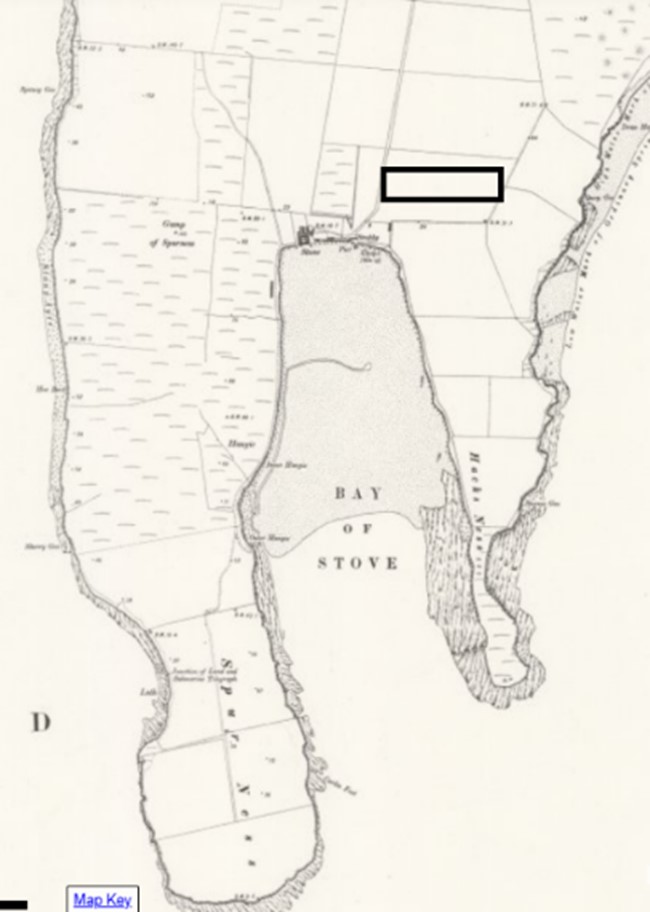
OS 6” map of the area around the Bay of Stove (Sanday) with the field of Volyar marked. The location of the field is taken from Lamb: 31, 67. Orkney Sheet LXXXVII, reproduced with the permission of the National Library of Scotland.
Taylor makes the important point that the direction of travel Sveinn Ásleifarson took to Sanday must have been from the south, in fact the southwest, and we know from the saga that he was initially fleeing from Gairsay via Hellisey (Taylor: 44).
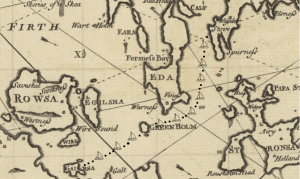
Detail from MacKenzie’s map of Orkney (1750) showing Gairsay, with Green Holm to the northeast and further on Stove, Sanday. Small boats suggest the route taken by Sveinn. Reproduced with the permission of the National Library of Scotland.
In looking for Hellisey there are not many islands between Gairsay and Sanday that fit the saga description. Sweyn Holm just off Gairsay is not ‘an island with sea-cliffs and a large cave in the mountain’ (chapter 95). Linga Holm (or Holm of Midgarth) west of Stronsay could be the island in question but it rises to only 18m in height and has relatively flat coastal areas with no apparent sea caves. The other possibility, roughly halfway between Gairsay and the southern tip of Sanday, is Green Holm. Now known as Muckle Green Holm the name is clearly a later formation; it would have had an earlier name. This island rises to 28m in height, has high cliffs and boasts sea caves near to Otters Pool on the modern OS map. This, then, seems a likely spot for the saga story of Sveinn Ásleifarson’s hiding from Earl Haraldr with his ship.
A ‘medieval farmstead which is likely to be monastic in character’ (Canmore) has been found on Green Holm and this ties in nicely with the saga incident where the ever-chivalrous Sveinn Ásleifarson ‘took an old cargo-ship in the island, which had belonged to monks, and made for Sanday’, presumably stranding the monks on Hellisey.
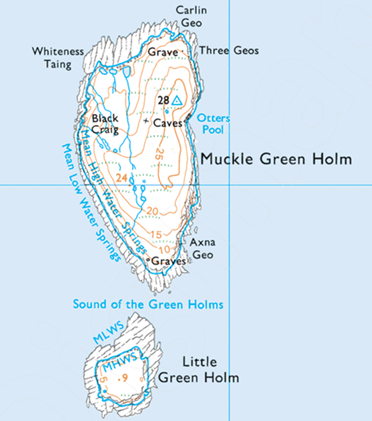
OS map showing Muckle Green Holm (1:10,000)
Whilst these suggestions for the lost place-names of Hellisey and Vǫlunes are contestable we can at least see the merits of following the journey and direction of travel of Sveinn Ásleifarson, in his wake so to speak, to help us cautiously unravel this little mystery. The process tells us something about the fragility of place-names; losing a farm-name like Vǫlunes is perhaps understandable, but that an island-name can almost vanish without trace, but for the saga recording the duplicitous antics of Sveinn Ásleifarson, is an instructive lesson for us to note.
Matthew Blake and Corinna Rayner
Further Reading
Cleasby, Richard, and Gudbrand Vigfusson, An Icelandic-English Dictionary (Oxford: Clarendon Press, 1874).
Lamb, Gregor, Naggles o Piapittem: Place Names of Sanday (Orkney: Byrgisey, 1992).
Marwick, Hugh, ‘Antiquarian Notes on Sanday’, Proceedings of the Orkney Antiquarian Society (Kirkwall: Orkney Antiquarian Society, 1923), pp. 21–29.
Marwick, Hugh, Orkney Farm Names (Kirkwall: W. R. Mackintosh, 1952).
Peterkin, A. (ed.), Rentals of the Ancient Earldom and Bishoprick of Orkney 1502–3 and 1595 (Edinburgh: J. Moir, 1820).
Pollard E., J. Gibson and M. Littlewood, ‘Interpreting medieval inter-tidal feature at Weelie’s Taing on Papa Westray, Orkney, NE Scotland’ Journal of Maritime Archaeology, 11 (2016), pp. 299–322.
Sigurðardóttir, Aldís et al, eds, Dictionary of Old Norse Prose (ONP) (Copenhagen: University of Copenhagen, 1989‒2021).
Sinclair, John and Clouston, J. Storer, The Orkney Parishes containing The Statistical Account of Orkney, 1795–1798 (Kirkwall: W. R. Mackintosh, 1927).
Taylor, A. B., ‘Some saga place-names’, Proceedings of the Orkney Antiquarian Society (Kirkwall: Orkney Antiquarian Society, 1922–28) pp. 41–45.
No comments yet, fill out a comment to be the first

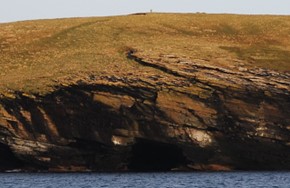
Leave a Reply